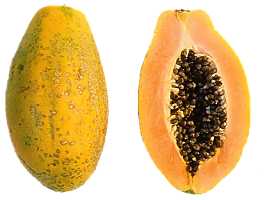|
Carica papaya (Papaya, Papaw, Pawpaw)
papaja [Afrikaans];phopho [N Sotho, Sesotho];
phoophoo [Tswana]; ipopo [Xhosa]; upopo [Zulu]
Life
> eukaryotes >
Archaeoplastida >
Chloroplastida
>
Charophyta > Streptophytina > Plantae (land plants)
> Tracheophyta (vascular plants) > Euphyllophyta > Lignophyta (woody plants)
> Spermatophyta (seed plants) > Angiospermae (flowering
plants) > Eudicotyledons > Core Eudicots > Rosids >
Eurosid II > Order: Brassicales
> Family: Caricaceae

Papaya. Left, whole fruit; right, fruit cut open
revealing the numerous black seeds that are removed from
the fruit before it is eaten. |
The Papaya originates from Mexico and Central
America and is now cultivated widely in tropical and subtropical
regions of the world. It is eaten raw as a fruit and contains high
levels of Vitamins A and C and a phytochemical called beta-cryptoxanthin
that promotes health. It also contains papain, which is an
antibacterial protease enzyme that has meat tenderising properties
and is used for clarifying beer. Flowers of Papaya trees can be male, female or both
(hermaphrodite) and have a sweet-scented smell at night that
attracts pollinating moths.
Note that the term Papaw or Pawpaw is also used
for a completely different plant called
Asimina triloba, which is native to North America. In North
America, the term Papaw or Pawpaw is used exclusively to refer to
Asimina triloba and the term Papaya is used exclusively to refer
to Carica papaya. Biodiversity Explorer focuses on the
biodiversity of southern Africa and in this region the term Pawpaw
is usually used to refer to Carica papaya; the term Papaya is
less commonly used. As far as I know, Asimina triloba is not
cultivated at all in southern Africa. Thanks to Martin Miranda for
bringing the confusing use of the term papaw to my attention.
Ecological interactions
Pollinators
-
Insects >
Lepidoptera >
Sphingidae (hawkmoths).
Martins & Johnson (2009) in a study conducted in rural Kenya,
found that natural habitats were important in sustaining
hawkmoth populations because they contained the larval
hostplants needed in completing the life cycle. Hence, papaya
plants grown near natural habitats were more likely to be
pollinated than those isolated from natural habitats. They
recorded the following hawkmoth species as pollinators:
Publications (by date)
-
van Wyk, B.-E. 2005. Food Plants of the World -
Identification, Culinary Uses and Nutritional Value. Briza, Pretoria.
-
Martins DJ, Johnson SD. 2009. Distance and quality of
natural habitat influence hawkmoth pollination of cultivated papaya.
International Journal of Tropical Insect Science 29: 114-123.
http://dx.doi.org/10.1017/S1742758409990208
Text by Hamish Robertson |
